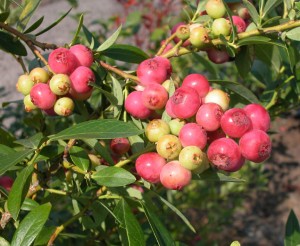Pink Lemonade blueberry (Vaccinium x ‘Pink Lemonade’) is a new variety introduction from the USDA. It combines the benefits of growing a beautiful landscape plant and one that produces a tasty crop of pinkish red blueberries. Pink Lemonade is also very winter hardy (USDA hardiness zone 4).
Select a sunny location, preferably with an eastern or northern exposure. Ground prep should begin at least one year ahead of planting date to lower the pH (recommend 4.5 – 5.5 range) and to raise the organic level of the soil. The ground must also be well-drained and compost-rich. Reduce weeds with frequent soil tillage and/or applying herbicides according to label directions.
Attractive pinkish-white, bell-shaped flowers open in the spring. Fruits ripen to a deep pink color in mid to late July in the Southern Appalachian region (USDA hardiness zones 6 and 7). Blueberry leaves have an attractive glossy green cast and exhibit few disease and insect problems. In autumn leaves turn bright orange to deep red color and fruit stems are bright red at the start of winter.
Pink Lemonade is vigorous, reaching 4 to 5 feet in height and width. The medium-sized, glossy, bright pink blueberries ripen in late season compared to other varieties. Berries have a mild sweet flavor with good fruit firmness.
Many gardeners cover plants with netting as harvest time nears and the birds invade the blueberry planting. In late summer remove the netting to allow the hungry birds and other wildlife to consume unharvested fruits.
Wait two years for the blueberry plants to establish before producing the first crop. Space blueberry bushes 5 to 7 feet apart in rows 8 feet apart. Mulch with 3 to 4 inches of sawdust, wood chips or pine needles to maintain soil acidity and retain moisture.
Plants are shallow rooted and should be irrigated regularly, particularly if natural rainfall amounts are low. Feed plants in late winter with 10-10-10 or equivalent fertilizer @ 2 lbs per 100 square feet. Blueberries are pruned in late winter.


 Posted in
Posted in 
